When the ‘Asset’ Is Livelihood: Making Heritage with the Maritime Practitioners of Bagamoyo, Tanzania
Abstract
:1. Introduction
2. Context: The Maritime ‘Heritage’ of Bagamoyo
3. Retrospective: Formal Engagements with Tanzania’s Maritime Heritage
4. The Bahari Yetu, Urithi Wetu Project and Its Activities
4.1. Stakeholders—In the Project and the ‘Heritage’
4.2. Approaches and Methodologies
5. Heritage as Livelihood
6. Pressure Points
6.1. The BSEZ
6.2. Fisheries Sustainability
6.3. Technological Change
6.4. Availability of Timber Resources
6.5. Tourism
6.6. Climate Change and Coastal Erosion
7. Heritage Strategies for Community Benefit
7.1. Raising Awareness
7.2. Organisation and Empowerment
7.3. Planning and Policy Engagement
8. Conclusions
Author Contributions
Funding
Institutional Review Board Statement
Informed Consent Statement
Data Availability Statement
Acknowledgments
Conflicts of Interest
Appendix A
| Question | Category | % | Average |
|---|---|---|---|
| What is your age? | 18 –25 | 24 | - |
| 26–35 | 27 | - | |
| 36–45 | 15 | - | |
| 46–55 | 20 | - | |
| 56–65 | 8 | - | |
| Over 65 | 7 | - | |
| What is your gender? | M | 55 | - |
| F | 45 | - | |
| Where are you from? | Tanzania | 9 | - |
| Other Africa | 14 | - | |
| Europe | 50 | - | |
| Americas | 17 | - | |
| Asia | 4 | - | |
| Australasia | 4 | - | |
| How many times have you visited Bagamoyo? | - | 1.4 | |
| How many days have you been here? | - | 2.8 | |
| How many days will you stay in total? | - | 6.2 | |
| Where are you staying? | Hotel | 63 | - |
| Hostel | 4 | - | |
| Camping | 8 | - | |
| Private House | 15 | - | |
| Other | 12 | - | |
| Who are you travelling with? | Family | 35 | - |
| Friends | 38 | - | |
| Work colleagues | 12 | - | |
| Alone | 9 | - | |
| Where will you visit while you are here? | The beach | 86 | - |
| The fort | 42 | - | |
| Kaole ruins | 53 | - | |
| Caravanserai | 30 | - | |
| The Old Boma building | 39 | - | |
| A church | 48 | - | |
| A mosque | 13 | - | |
| Fish market | 47 | - | |
| Cafés | 27 | - | |
| Bars | 23 | - | |
| Restaurants | 50 | - | |
| Gift shops | 33 | - | |
| Wildlife attractions | 13 | - | |
| Tourist Office | 13 | - | |
| How did you find out about these places? | I’ve been here before | 13 | - |
| Walking around | 11 | - | |
| Family or friends’ recommendations | 32 | - | |
| From local people | 24 | - | |
| Guide book | 18 | - | |
| Internet | 18 | - | |
| What will you do while you are here? | Swim | 47 | - |
| Relax on the beach | 55 | - | |
| Exercise on the beach | 15 | - | |
| Make a religious visit | 14 | - | |
| Visit historic places | 83 | - | |
| Go to a nightclub | 3 | - | |
| Go fishing | 3 | - | |
| Go on a boat | 15 | - | |
| Which of the following would you consider doing in Bagamoyo if they were available? | Go on a short boat trip (1–2 hrs) | 53 | - |
| Go on a fishing trip by boat | 38 | - | |
| Go on a snorkelling trip by boat | 40 | - | |
| Visit an island by boat | 57 | - | |
| Would you prefer this to be… | …On a traditional boat with sail? | 50 | - |
| …On a traditional boat with engine? | 26 | - | |
| …On a modern boat with engine? | 10 | - | |
| I don’t mind. | 22 | - | |
| [Total respondents: 92] | |||
References
- Ichumbaki, E.B. Maritime and Underwater Cultural Heritage of the United Republic of Tanzania: History, Opportunities and Future Directions. In Shipwrecks around the World: Revelations of the Past; Tripati, S., Ed.; Delta Book World: New Delhi, India, 2015; pp. 526–536. [Google Scholar]
- Hafidh, H.A.; Rashid, Z.A. The Impact of Tourism Development on Economic Development: The Case of Zanzibar. Asian J. Edu. Soc. Stud. 2021, 18, 41–50. [Google Scholar] [CrossRef]
- Thurlow, C.; Jaworski, A. Banal Globalization? Embodied Actions and Mediated Practices in Tourists’ Online Photo Sharing. In Digital Discourse: Language in the New Media; Thurlow, C., Mroczek, K., Eds.; Oxford University Press: Oxford, UK, 2011; pp. 220–250. [Google Scholar]
- Ichumbaki, E.B. A History of Conservation of Built Heritage Sites of the Swahili Coast in Tanzania. Afr. Hist. Rev. 2016, 48, 43–67. [Google Scholar] [CrossRef]
- Forster, N. A Note on Some Ruins near Bagamoyo. Tang. Note Rec. 1937, 3, 106–109. [Google Scholar]
- Chittick, N. Kilwa: An Islamic Trading City on the East African Coast; The British Institute in Eastern Africa: Nairobi, Kenya, 1974. [Google Scholar]
- Sutton, J. Kilwa: A History of the Ancient Swahili Town with a Guide to the Monuments of Kilwa Kisiwani and Adjacent Islands. Azania 1998, 33, 113–169. [Google Scholar] [CrossRef]
- Chami, F.A. The Tanzanian Coast in the First Millennium AD; Societas Archaeologica Upsaliensis: Uppsala, Finland, 1994. [Google Scholar]
- Chami, F.A. The Excavation of Kaole Ruins. Stud. Afr. Past 2002, 2, 25–49. [Google Scholar]
- Chami, F.A. The Archaeology of Pre-Islamic Kilwa Kisiwani (Island). Stud. Afr. Past 2006, 5, 119–150. [Google Scholar]
- Ichumbaki, E.B.; Mapunda, B.B.B. Challenges to the Retention of the Integrity of World Heritage Sites in Africa: The Case of Kilwa Kisiwani and Songo Mnara, Tanzania. Azania 2017, 52, 518–539. [Google Scholar] [CrossRef]
- Wynne-Jones, S. Creating Urban Communities at Kilwa Kisiwani, Tanzania, AD 800–1300. Antiquity 2007, 81, 368–380. [Google Scholar] [CrossRef]
- Wynne-Jones, S. Kilwa Kisiwani and Songo Mnara. In The Swahili World; Wynne-Jones, S., Adria LaViolette, A., Eds.; Routledge: London, UK, 2017; pp. 2417–2515. [Google Scholar] [CrossRef]
- Pollard, E.J.D. An Archaeology of Tanzanian Coastal Landscapes in the Middle Iron Age (6th to 15th Centuries AD). Ph.D. Thesis, University of Ulster, Ulster, UK, 2007. [Google Scholar]
- Pollard, E. Settlement Adaptation to a Changing Coastline: Archaeological Evidence from Tanzania, during the First and Second Millennia AD. J. Isl. Coast. Arch. 2009, 4, 82–107. [Google Scholar] [CrossRef]
- Fleisher, J.; Wynne-Jones, S.; Steele, C.; Welham, K. Geophysical Survey at Kilwa Kisiwani, Tanzania. J. Afr. Arch. 2012, 10, 207–220. [Google Scholar] [CrossRef]
- Ichumbaki, E.B. Introducing the ‘Archaeology of Trees’ in African Historical Archaeology. In Proceedings of the 24th Biennial Meeting of the Society of Africanist Archaeologists, Toronto, ON, Canada, 18–22 June 2018. [Google Scholar]
- Baillie, B.; Sørensen, M.L.S. Heritage Challenges in Africa: Contestations and Expectations. In African Heritage Challenges. Globalization, Urbanization and Development in Africa; Baillie, B., Sørensen, M.L.S., Eds.; Palgrave Macmillan: Singapore, 2021; pp. 1–43. [Google Scholar]
- Brown, W.T. The Politics of Business: Relations between Zanzibar and Bagamoyo in the Late Nineteenth Century. Afr. Hist. Stud. 1971, 4, 631–643. [Google Scholar] [CrossRef]
- Brown, W.T. A Pre-colonial History of Bagamoyo: Aspects of the Growth of an East African Coastal Town. Ph.D. Thesis, Boston University, Boston, MA, USA, 1983. [Google Scholar]
- Sheriff, A. Slaves, Spices & Ivory in Zanzibar: Integration of an East African Commercial Empire into the World Economy, 1770–1873; James Currey: London, UK, 1987. [Google Scholar]
- Chami, F.A.; Maro, E.; Kessy, J.; Odunga, S. Historical Archaeology of Bagamoyo: Excavation at the Caravan-Serai; Dar es Salaam University Press: Dar es Salaam, Tanzania, 2004. [Google Scholar]
- Mapunda, B.B.B. Bagamoyo: From a Slave Port to a Tourist Destination. East. Afr. J. Devel. Stud. 2006, 1, 1–19. [Google Scholar]
- Fabian, S. Curing the Cancer of the Colony: Bagamoyo, Dar es Salaam, and Socioeconomic Struggle in German East Africa. Int. J. Afr. Hist. Stud. 2007, 40, 441–469. [Google Scholar]
- Livingstone, D. The Last Journals of David Livingstone, in Central Africa, from 1865 to his Death, Continued by a Narrative of His Last Moments and Sufferings, Obtained from His Faithful Servants Chuma and Susi, by Horace Waller. Vol. 2; John Murray: London, UK, 1874. [Google Scholar]
- National Bureau of Statistics. 2012 Population and Housing Census: Population Distribution by Administrative Areas; National Bureau of Statistics: Dar Es Salaam, Tanzania, 2013.
- Schmidt, P.; Ichumbaki, E.B. Is there Hope for Heritage in Former British Colonies of East Africa? A View from Tanzania. J. Afr. Cult. Heritage Stud. 2020, 2, 26–51. [Google Scholar] [CrossRef]
- Lello, D.S.; Mwasanyila, P.C. Local Community-Based Participation on Conservation of Heritage Buildings: Experiences from Bagamoyo Historical Town, Tanzania. Int. Res. J. Eng. Tech. 2018, 5, 2212–2226. [Google Scholar]
- Lindström, J. Muted Memories: Heritage-Making, Bagamoyo, and the East African Caravan Trade; Berghahn: New York, NY, USA; Oxford, UK, 2019. [Google Scholar]
- Bodiguel, C.; Breuil, C. Report of the Meeting on the Small Marine Pelagic Fishery in the United Republic of Tanzania; Report SF-FAO/2015/34, SmartFish Programme of the Indian Ocean Commission; Indian Ocean Commission: Ebene, Mauritius, 2015. [Google Scholar]
- Bradford, K.; Katikiro, R.E. Fighting the Tides: A Review of Gender and Fisheries in Tanzania. Fish Res. 2019, 216, 79–88. [Google Scholar] [CrossRef]
- Cooper, J.P.; Blue, L.K.; Ghidoni, A.; Ichumbaki, E.B. Contemporary Wooden Watercraft of the Zanzibar Channel, Tanzania: Type and Technologies, Innovation and Change. Intl. J. Naut. Arch. 2021, 50. [Google Scholar] [CrossRef]
- Ichumbaki, E.B.; Cooper, J.P.; Maligisu, P.C.M.; Robinson, S.; Blue, L.K.; Biginagwa, T.J. Building a Ngalawa Double-Outrigger Logboat in Bagamoyo, Tanzania: A Craftsman at His Work. Int. J. Naut. Arch. 2021, 50. [Google Scholar] [CrossRef]
- Tairo, A. Tanzania Surrenders Bagamoyo Port Project to Chinese Firm. The East African. 3 October 2017. Available online: https://www.theeastafrican.co.ke/business/Tanzania-Bagamoyo-port-project-to-Chinese/2560-4122244-rxa9wtz/index.html (accessed on 18 February 2022).
- The Citizen. Chinese Investors Eye Mega Projects in Bagamoyo SEZ. The Citizen. 12 November 2018. Available online: https://www.thecitizen.co.tz/tanzania/news/-chinese-investors-eye-mega-projects-in-bagamoyo-sez-2661306. (accessed on 18 February 2022).
- Van Mead, N. China in Africa: Win-Win Development, or a New Colonialism? The Guardian. 31 July 2018. Available online: https://www.theguardian.com/cities/2018/jul/31/china-in-africa-win-win-development-or-a-new-colonialism. (accessed on 18 February 2022).
- Zou, Z. China’s Participation in Port Construction in the Western Indian Ocean Region: Dynamics and Challenges. Asian J. Middle East Islam Stud. 2021, 15, 489–504. [Google Scholar] [CrossRef]
- Textile Development Unit in Tanzania. Bagamoyo Special Economic Zone. Available online: https://tdu.or.tz/doc/bagamoyo-special-economic-zone/print/ (accessed on 18 February 2022).
- Sky News Network. Tanzania to Revive $10 Billion Port Project. Sky News Network. 28 June 2021. Available online: http://skynewsug.com/tanzania-to-revive-10-billion-port-project/ (accessed on 18 February 2022).
- African Development Bank Group, Tanzania Economic Outlook. 2021. Available online: https://www.afdb.org/en/countries-east-africa-tanzania/tanzania-economic-outlook (accessed on 18 February 2022).
- United Nations, Department of Economic and Social Affairs, Population Division. World Population Prospects 2019. Volume I: Comprehensive Tables. ST/ESA/SER.A/423. 2019. Available online: https://population.un.org/wpp/publications/Files/WPP2019_Volume-I_Comprehensive-Tables.pdf (accessed on 18 February 2022).
- Chittick, N. Manda: Excavations at an Island Port on the Kenya Coast; British Institute in Eastern Africa: Nairobi, Kenya, 1984. [Google Scholar]
- Horton, M. Shanga: The Archaeology of a Muslim Trading Community on the Coast of East Africa; Oxbow Books for the British Institute in East Africa: Oxford, UK, 1996. [Google Scholar]
- Fleisher, J.; Lane, P.; LaViolette, A.; Horton, M.; Pollard, E.; Morales, E.Q.; Vernet, T.; Christie, A.; Wynne-Jones, S. When Did the Swahili Become Maritime? Am. Anthropol. 2015, 117, 100–115. [Google Scholar] [CrossRef]
- Mjema, E. The Indigenous Roots of Swahili Culture in Pangani Bay, Tanzania. In African Archaeology Without Frontiers; Sadr, K., Esterhuysen, A., Seivers, C., Eds.; Wits University Press: Johannesburg, South Africa, 2016; pp. 48–59. [Google Scholar]
- Ichumbaki, E.B. When Did the Swahili Become Maritime? A Reply to Jeffrey Fleisher et al. 2015. In Sea Ports and Sea Power: Approaches to African Maritime Landscape; Harris, L., Ed.; Springer: New Delhi, India, 2017; pp. 1–11. [Google Scholar] [CrossRef]
- Ichumbaki, E.B. Methodological Approaches to Researching Maritime and Underwater Cultural Heritage Along the Swahili Coast in Tanzania. In Maritime and Underwater Cultural Heritage Management on the Historic and Arabian Trade Routes; Parthesius, R., Sharfman, J., Eds.; Springer: Cham, Switzerland, 2020. [Google Scholar] [CrossRef]
- Kusimba, C.M.; Walz, J.R. When Did the Swahili Become Maritime?: A Reply to Fleisher et al. (2015), and to the Resurgence of Maritime Myopia in the Archaeology of the East African Coast. Am. Anthropol. 2018, 120, 429–443. [Google Scholar] [CrossRef]
- Horton, M.; Middleton, J. The Swahili: The Social Landscape of a Mercantile Society; Blackwell Publishers: Oxford, UK, 2000. [Google Scholar]
- Lane, P.J. Maritime Archaeology: A Prospective Research Avenue in Tanzania. In Salvaging Tanzania’s Cultural Heritage; Mapunda, B., Memwa, P., Eds.; Dar Es Salaam University Press: Dar Es Salaam, Tanzania, 2005; pp. 95–131. [Google Scholar]
- Mahudi, H. Establishing a Maritime Cultural Heritage Unit in Tanzania. In Proceedings of the Asia-Pacific Regional Conference on Underwater Cultural Heritage, Manila; Staniforth, M., Craig, J., Jago-on, S.C., Orillaneda, B., Lascina, L., Eds.; Australian National Commission for UNESCO: Canberra, Australia, 2011; pp. 599–612. [Google Scholar]
- Jeffrey, B.; Parthesius, R. Maritime and Underwater Cultural Heritage in Tanzania and Mozambique. J. Marit. Archaeolog. 2013, 8, 153–178. [Google Scholar] [CrossRef]
- Pollard, E.J. The Maritime Landscape of Kilwa Kisiwani and Its Region, Tanzania, 11th to 15th century AD. J. Anthropol. Archaeol. 2008, 27, 265–280. [Google Scholar] [CrossRef]
- Ichumbaki, E.B.; Pollard, E. Valuing the Swahili Cultural Heritage: A Maritime Cultural Ecosystem Services Study from Kilwa, Tanzania. Conserv. Manag. Archaeol. Sit. 2020, 21, 230–255. [Google Scholar] [CrossRef]
- Mjeme, E. World War I Shipwrecks of the Western Indian Ocean of Tanzania: Neglected Underwater Heritage Resources. In Sea Ports and Sea Power; Harris, L., Ed.; Springer: Cham, Switzerland, 2017; pp. 67–75. [Google Scholar]
- Pollard, E.; Bates, R.; Ichumbaki, E.B.; Bita, C. Shipwrecks Evidence from Kilwa, Tanzania. Int. J. Naut. Archaeol. 2016, 45, 352–369. [Google Scholar] [CrossRef] [Green Version]
- Piercy, R. Mombasa Wreck Excavation, Preliminary Report. Int. J. Naut. Archaeol. 1977, 6, 331–347. [Google Scholar] [CrossRef]
- Piercy, R. Mombasa Wreck Excavation, Second Preliminary Report. Int. J. Naut. Archaeol. 1978, 7, 301–319. [Google Scholar] [CrossRef]
- Piercy, R. Mombasa Wreck Excavation, Third Preliminary Report. Int. J. Naut. Archaeol. 1979, 8, 303–309. [Google Scholar] [CrossRef]
- Piercy, R. Mombasa Wreck Excavation, Fourth Preliminary Report. Int. J. Naut. Archaeol. 1981, 10, 109–318. [Google Scholar] [CrossRef]
- Lynch, M. The Mombasa Wreck Excavation. INA Newsletter 1991, 18, 1–32. [Google Scholar]
- Bita, C. The Western Indian Ocean Maritime Heritage: An Overview of the Maritime Archaeological Heritage in Malindi; British Institute in Eastern Africa: Nairobi, Kenya, 2008. [Google Scholar]
- Bita, C. The Potential of Underwater Archaeology in Kenya: A Short Communication. In Shipwrecks around the World: Revelations of the Past; Tripati, S., Ed.; Delta Book World: New Delhi, India, 2015; pp. 486–510. [Google Scholar]
- Duarte, R.M.T. Arqueonautas’ Intervention in Mozambique Island; Unpublished ICUCH Report: Maputo, Mozambique, 2010. [Google Scholar]
- Duarte, R.T. Maritime History in Mozambique and East Africa: The Urgent Need for the Proper Study and Preservation of Endangered Underwater Cultural Heritage. J. Marit. Archaeol. 2012, 7, 63–86. [Google Scholar] [CrossRef]
- Pollard, E.; Fleisher, J.; Wynne-Jones, S. Beyond the Stone Town: Maritime Architecture at Fourteenth-Fifteenth Century Songo Mnara, Tanzania. J. Marit. Archaeol. 2012, 7, 43–62. [Google Scholar] [CrossRef]
- Ichumbaki, E.B. Archaeological and Ethnographic Evidence for the Historic Consumption of Fish and Shellfish along the Coast of East Africa in Tanzania. J. Indian Ocean Archaeol. 2014, 10, 1–18. [Google Scholar]
- Quintana Morales, E.M.; Horton, M. Fishing and Fish Consumption in the Swahili Communities of East Africa, 700–1400 CE. Internet Archaeol. 2014, 37. [Google Scholar] [CrossRef] [Green Version]
- De Leeuwe, R. Constructing Sailing Ships on the Swahili Shores. Azania 2005, 40, 107–113. [Google Scholar] [CrossRef]
- Falck, W.E. Boats and Boatbuilding in Tanzania (Dar-es-Salaam and Zanzibar). Int. J. Naut. Archaeol. 2014, 43, 162–173. [Google Scholar] [CrossRef]
- Haddon, A.C. The Outrigger Canoe of East Africa. Man 1918, 18, 49–54. [Google Scholar] [CrossRef]
- Hornell, J. The Common Origin of the Outrigger Canoes of Madagascar and East Africa. Man 1920, 20, 134–139. [Google Scholar] [CrossRef]
- Robinson, A.E. Some Notes on Ancient Means of Water Transport in Relation to the Vessels of East Africa. Tang. Note Rec. 1937, 4, 65–71. [Google Scholar]
- Morgan, J.C. The Ngalawa of the Kilwa Coast. Tang. Note Rec. 1940, 56, 27–36. [Google Scholar]
- Hatchell, G.W. The Ngalawa and the Mtepe. Tang. Note Rec. 1961, 56, 210–215. [Google Scholar]
- Wenban-Smith, H. The Coastal Fisheries Near Dar Es Salaam. Tang. Note Rec. 1963, 60, 165–174. [Google Scholar]
- Prins, A.H.J. The Mtepe of Lamu, Mombasa and the Zanzibar Sea. Paid. Mitt. Kult. 1982, 28, 85–100. [Google Scholar]
- Prins, A.H.J. A Handbook of Sewn Boats: The Ethnography and Archaeology of Archaic Plank-Built Craft; National Maritime Museum: Greenwich, UK, 1986. [Google Scholar]
- Mapunda, B.; Lane, P. Archaeology for Whose Interest—Archaeologists or the Locals? In Public Archaeology; Merriman, N., Ed.; Routledge: London, UK; New York, NY, USA, 2004; pp. 211–223. [Google Scholar]
- Breuil, C.; Grima, D. Baseline Report Tanzania. In SmartFish Programme of the Indian Ocean Commission, Fisheries Management FAO Component; Indian Ocean Commission: Ebene, Mauritius, 2014. [Google Scholar]
- Fröcklin, S.; de la Torre-Castro, M.; Håkansson, E.; Carlsson, A.; Magnusson, M.; Jiddawi, N.S. Towards Improved Management of Tropical Invertebrate Fisheries: Including Time Series and Gender. PLoS ONE 2014, 9, e91161. [Google Scholar] [CrossRef] [Green Version]
- Kanyange, N.; Kimani, P.; Onyango, P.; Sweenarain, S.; Yvergniaux, Y. Performance Assessment of Beach Management Units along the Coastlines of Kenya and Tanzania; Report SF/2014/47; Programme for the Implementation of a Regional Fisheries Strategy for the Eastern and Southern Africa–Indian Ocean Region; Indian Ocean Commission: Ebene, Mauritius, 2014. [Google Scholar]
- Moshy, V.; Briceson, I. Seeing Through Fishers’ Lenses: Exploring Marine Ecological Changes Within Mafia Island Marine Park, Tanzania. SAGE Open 2016, 6, 1–18. [Google Scholar] [CrossRef] [Green Version]
- Agius, D.A. In the Wake of the Dhow: The Arabian Gulf and Oman; Ithaca Press: Reading, UK, 2002. [Google Scholar]
- Roberts, H. The British Ratification of the Underwater Heritage Convention: Problems and Prospects. Int. Comp. Law Q 2018, 67, 833–865. [Google Scholar] [CrossRef] [Green Version]
- Varmer, O. United States of America. In The Protection of the Underwater Cultural Heritage: National Perspectives in Light of the UNESCO Convention 2001; Dromgoole, S., Ed.; Martinus Nijhoff Publishers: Leiden, The Netherlands; Boston, MA, USA, 2006; pp. 351–385. [Google Scholar]
- Henderson, J.; Breen, C.; Esteves, L.; La Chimia, A.; Lane, P.; Macamo, S.; Marvin, G.; Wynne-Jones, S. Rising from the Depths Network: A Challenge-Led Research Agenda for Marine Heritage and Sustainable Development in Eastern Africa. Heritage 2021, 4, 1026–1048. [Google Scholar] [CrossRef]
- Mapunda, B.B. The Role of Archaeology in Development: The Case of Tanzania. Transafr. J. Hist. 1991, 20, 19–34. [Google Scholar]
- Mapunda, B.B. Sharing Archaeological Knowledge with the Local People: The Face of the Ruhuhu River Basin. In Proceedings of the 11th Biennial Conference of the Society of Africanist Archaeologists, Los Angeles, CA, USA, 28–29 March 1992. [Google Scholar]
- Schmidt, P.R.; Kehoe, A.B. Archaeologies of Listening: Beginning Thoughts. In Archaeologies of Listening; Schmidt, P.R., Kehoe, A.B., Eds.; University Press of Florida: Gainesville, FL, USA, 2019; pp. 1–22. [Google Scholar] [CrossRef]
- Said, E. Orientalism; Routledge & Kegan Paul: London, UK, 1978. [Google Scholar]
- Mudimbe, V.Y. The Invention of Africa: Gnosis, Philosophy and the Order of Knowledge; Indiana University Press: Bloomington, IN, USA, 1988. [Google Scholar]
- Tuhiwai Smith, L. Decolonizing Methodologies: Research and Indigenous Peoples; Zed Books: London, UK, 1999. [Google Scholar]
- Mbembe, A. On the Post-Colony; University of California Press: Oakland, CA, USA, 2001. [Google Scholar]
- Mignolo, W.D.; Walsh, C.E. On Decoloniality: Concepts, Analytics, Praxis; Duke University Press: Durham, NC, USA; London, UK, 2018. [Google Scholar]
- Santos, B.D. Epistemologies of the South: Justice against Epistemicide; Routledge: London, UK; New York, NY, USA, 2014. [Google Scholar]
- Santos, B.D. The End of Cognitive Empire: The Coming of Age of Epistemologies of the South; Duke University Press: Durham, NC, USA; London, UK, 2018. [Google Scholar]
- Chirikure, S. Ethno Plus Archaeology: What is There for Africa(ns)? World Archaeol. 2016, 48, 693–699. [Google Scholar] [CrossRef]
- Schmidt, P.; Pikirayi, I. Community Archaeology and Heritage in Africa: Decolonizing Practice; Routledge: London, UK, 2016. [Google Scholar]
- The Challenge. Available online: https://risingfromthedepths.com/the-challenge-2-2/ (accessed on 6 August 2021).
- Chirikure, S.; Ndoro, W.; Bugarin, F.T.; di Lernia, S.; Ichumbaki, E.B.; Lwoga, N. Usable Pasts Forum: UNESCO and Heritage Tourism in Africa. Afr. Archaeol. Rev. 2021, 38, 513–533. [Google Scholar] [CrossRef]
- Nora, P. Realms of Memory: The Construction of the French Past, Volume 1—Conflicts and Divisions; Colombia University Press: New York, NY, USA, 1996. [Google Scholar]
- Smith, L. The Use of Heritage; Routledge: London, UK, 2006. [Google Scholar]
- Clifford-Collard, N. The Antimonies of Heritage: Tradition and the Work of Weaving in a Ghanaian Workshop. In African Heritage Challenges. Globalization, Urbanization and Development in Africa; Baillie, B., Sørensen, M.L.S., Eds.; Palgrave Macmillan: Singapore, 2021. [Google Scholar] [CrossRef]
- Facey, W. Oman: A Seafaring Nation; Ministry of Information and Culture: Muscat, Oman, 1979.
- Al-Hijji, Y.Y. The Art of Dhow-Building in Kuwait; London Centre of Arab Studies: London, UK, 2001. [Google Scholar]
- Moore, A. Last Days of Mast and Sail: Essay in Nautical Comparative Anatomy; David & Charles: Newton Abbott, UK, 1925. [Google Scholar]
- Hornell, J. Tentative Classification of Arab sea-craft. Mariners Mirror 1942, 28, 11–40. [Google Scholar] [CrossRef]
- Agius, D.A. Seafaring in the Arabian Gulf and Oman; Routledge: New York, NY, USA; London, UK, 2005. [Google Scholar]
- ICOMOS. Guidance on Heritage Impact Assessment for Cultural World Heritage Properties; ICOMOS: Paris, France, 2010. [Google Scholar]
- Claesson, S. The Value and Valuation of Maritime Cultural Heritage. Int. J. Cult. Prop. 2011, 18, 61–80. [Google Scholar] [CrossRef]
- UNESCO. Decision of the Intergovernmental Committee: 6.COM 8.10. Available online: https://ich.unesco.org/en/decisions/6.COM/8.10. (accessed on 15 March 2022).
- UNESCO. Convention for the Safeguarding of the Intangible Cultural Heritage. 2368 UNTS, Opened for Signature 17 October 2003, Entered into Force. 20 April 2006. Available online: https://treaties.un.org/doc/Publication/UNTS/Volume%202368/v2368.pdf. (accessed on 15 March 2022).
- Mashua captain, interviewed in Bagamoyo. 4 March 2020.
- Haule, W. Overview of the Small Pelagic Fishery of Mainland Tanzania. In Meeting on the Small Pelagic Marine Fishery in the United Republic of Tanzania, Bagamoyo-Tanzania; Bodiguel, C., Breuil, C., Eds.; Report SF-FAO/2015/34, SmartFish Programme of the Indian Ocean Commission; Indian Ocean Commission: Ebene, Mauritius, 2015; pp. 26–43. [Google Scholar]
- Fisheries Department, Bagamoyo District Council, Bagamoyo, Tanzania. Ref: Request for Various Data for the Research Project on the Maritime Cultural Heritage of Bagamoyo, Personal Communication. 2019.
- Older fishers from Bagamoyo and Mlingotini, group interview, 9 August 2019; mchoro crew members, Bagamoyo, interviewed. 17 August 2019.
- Taha, S. Mega Developments in Africa: Lessons from the Meroe Dam. In African Heritage Challenges. Globalization, Urbanization and Development in Africa; Baillie, B., Sørensen, M.L.S., Eds.; Palgrave Macmillan: Singapore, 2021; pp. 127–155. [Google Scholar] [CrossRef]
- Van Der Knaap, M. Smart Licensing of Artisanal Fisheries in The Coastal Waters of Tanzania (Mainland) With Emphasis on Small Pelagics; Indian Ocean Commission: Ebene, Mauritius, 2014. [Google Scholar]
- Kamat, V.R. Dynamite Fishing in a Marine Protected Area in Tanzania: Why Youth Perceptions Matter. Coast Manag. 2019, 47, 387–405. [Google Scholar] [CrossRef]
- Interviewed in Bagamoyo. 17 August 2019.
- Retired boat builder, interviewed in Mlingotini, 20 August 2019; retired boat builder, interviewed in Bagamoyo. 17 August 2019.
- Apprentice boat builder from Unguja, 28, iInterviewed in Mlingotini, 8 August 2019; Boat builder from Unguja, 50s, interviewed in Bagamoyo, 11 August 2019; retired boat builder from Mlingotini, interviewed 20 August 2019; group of four experienced boat builders, interviewed in Bagamoyo. 9 August 2019.
- Mbuya, L.P.; Msanga, H.P.; Ruffo, C.K.; Birnie, A.; Tengnäs, B. Useful Trees and Shrubs for Tanzania: Identification, Propagation and Management for Agricultural and Pastoral Communities; Technical Handbook No. 6; Regional Soil Conservation Unit, Swedish International Development Agency: Nairobi, Kenya, 1994. [Google Scholar]
- Dale, I.R.; Greenway, P.J. Kenya Trees & Shrubs; Buchanan: Nairobi, Kenya, 1961. [Google Scholar]
- Weiss, E.A. Some Indigenous Trees and Shrubs Used by Local Fishermen on the East African Coast. Econ. Bot. 1973, 27, 174–192. [Google Scholar] [CrossRef]
- Aldrick, J. The Nineteenth-century Carved Doors of the East African Coast. Azania 1990, 25, 1–18. [Google Scholar] [CrossRef]
- Walsh, M. Swahili Ethnobotany and Carved Doors. Azania 1992, 27, 135–136. [Google Scholar] [CrossRef]
- Boat builder, 20s, interviewed in Bagamoyo, 18 August 2019; Boat builder, 50s, interviewed in Bagamoyo. 11 August 2019.
- Interviewed in Bagamoyo. 10 March 2020.
- Bunce, M.; Brown, K.; Rosendo, S. Policy Misfits, Climate Change and Cross-Scale Vulnerability in Coastal Africa: How Development Projects Undermine Resilience. Environ. Sci. Policy 2010, 13, 485–497. [Google Scholar] [CrossRef]
- Pollard, E. Present and past Threats and Response on the East Coast of Africa: An Archaeological Perspective. J. Coast. Conserv. 2012, 16, 143–158. [Google Scholar] [CrossRef]
- Lyimo, J.G.; Ngana, J.O.; Liwenga, E.; Maganga, F. Climate Change, Impacts and Adaptations in the Coastal Communities in Bagamoyo District, Tanzania. Environ. Econ. 2013, 4, 63–71. [Google Scholar]
- Brooks, N.; Clarke, J.; Wambui Ngaruiya, G.; Wangui, E.E. African Heritage in a Changing Climate. Azania 2020, 55, 297–328. [Google Scholar] [CrossRef]
- Shemsanga, C.; Omambia, A.N.; Gu, Y. The Cost of Climate Change in Tanzania: Impacts and Adaptations. J. Am. Sci. 2010, 6, 182–196. [Google Scholar]
- Sekadende, B.; Scott, L.; Anderson, J.; Aswani, S.; Francis, J.; Jacobs, Z.; Jebri, F.; Jiddawi, N.; Kamukuru, A.T.; Kelly, S.; et al. The Small Pelagic Fishery of the Pemba Channel, Tanzania: What We Know and What We Need to Know for Management under Climate Change. Ocean Coast Manag. 2020, 197, 1–18. [Google Scholar] [CrossRef]
- Chemical x Centano x Honest—Bahari Yetu (Official Video). Available online: https://www.youtube.com/watch?v=QFd9TZYHezg. (accessed on 15 March 2022).
- Thurley, S. Into the Future. Our Strategy for 2005–2010. Conserv Bull. 2005, 49, 26–27. [Google Scholar]
- Harrison, R. Beyond “Natural” and “Cultural” Heritage: Toward and Ontological Politics of Heritage in the Age of Anthropocene. Herit. Soc. 2015, 8, 24–42. [Google Scholar] [CrossRef] [Green Version]
- Holtorf, C.; Fairclough, G. The New Heritage and Re-Shapings of the Past. In Reclaiming Archaeology: Beyond the Tropes of Modernity; González-Ruibal, A., Ed.; Routledge: Abingdon, UK; New York, NY, USA, 2013; pp. 197–210. [Google Scholar]

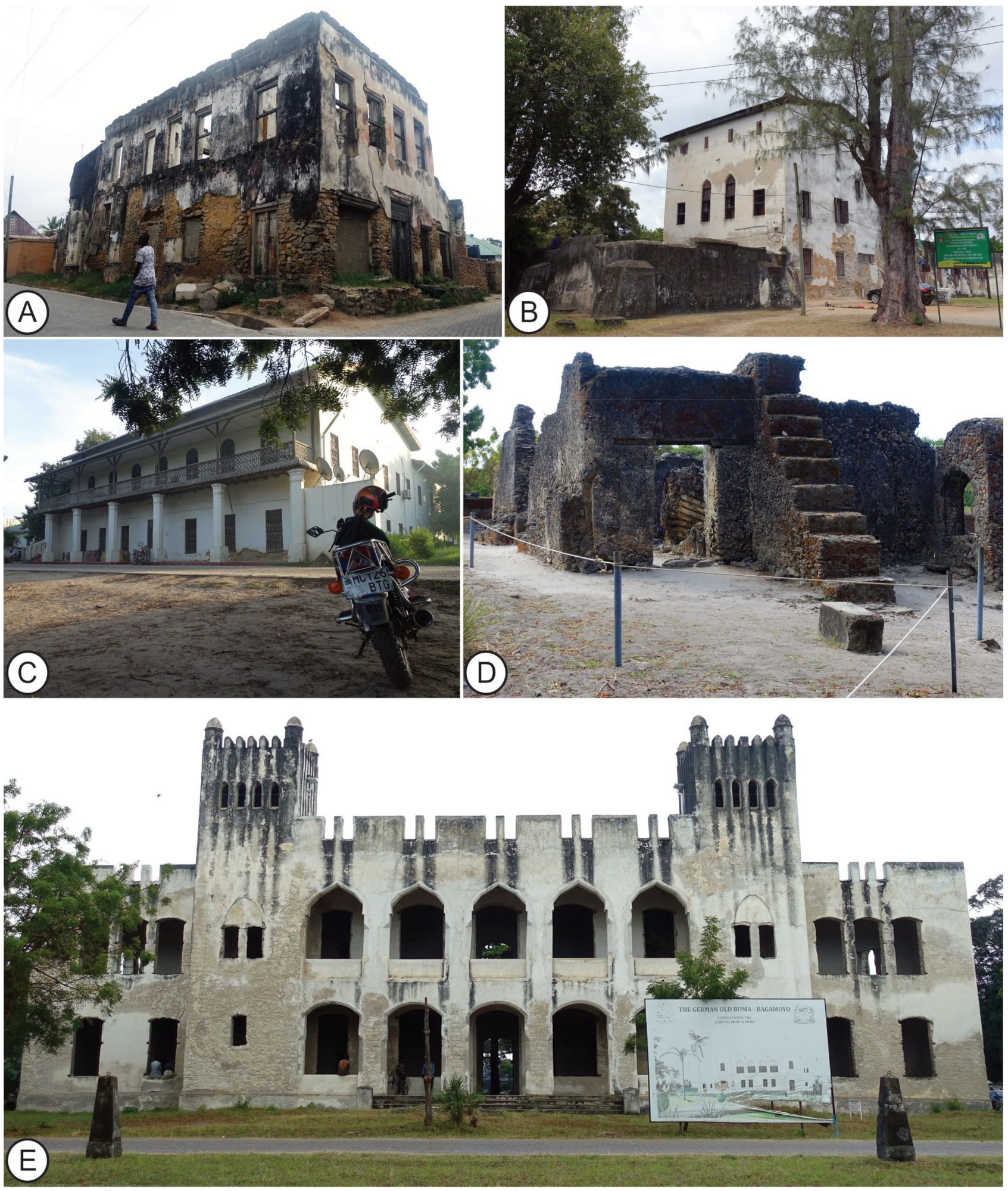
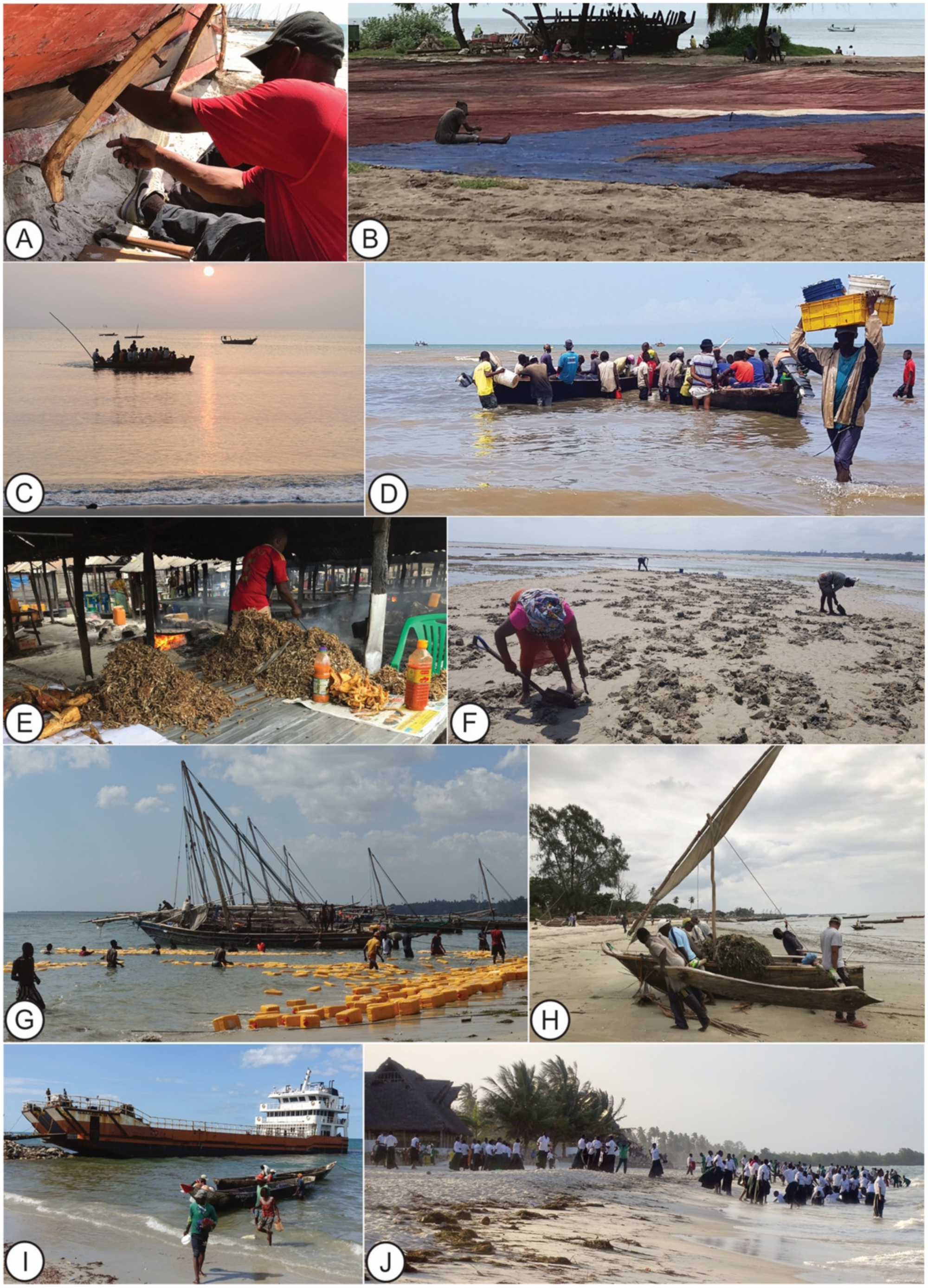
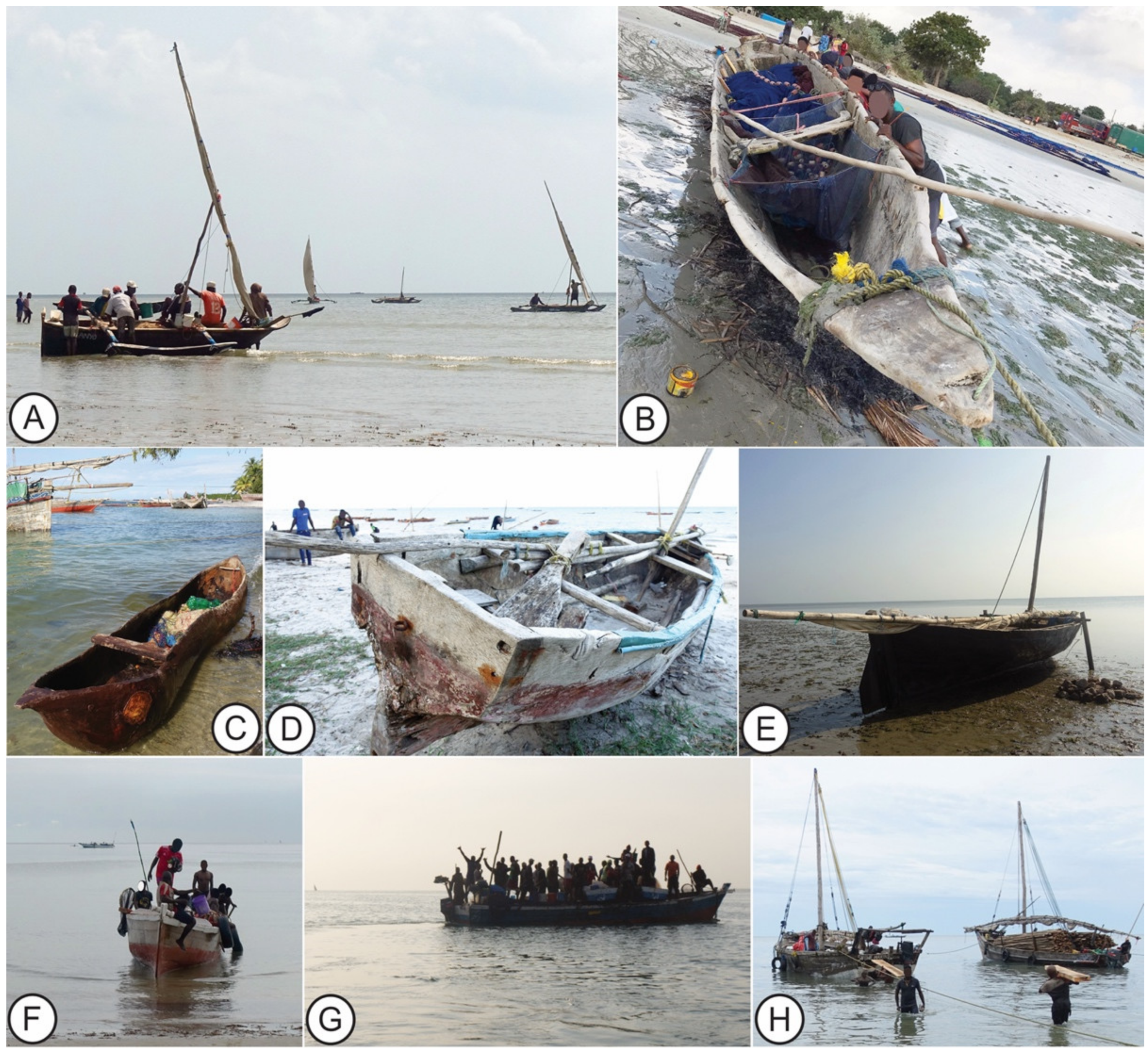
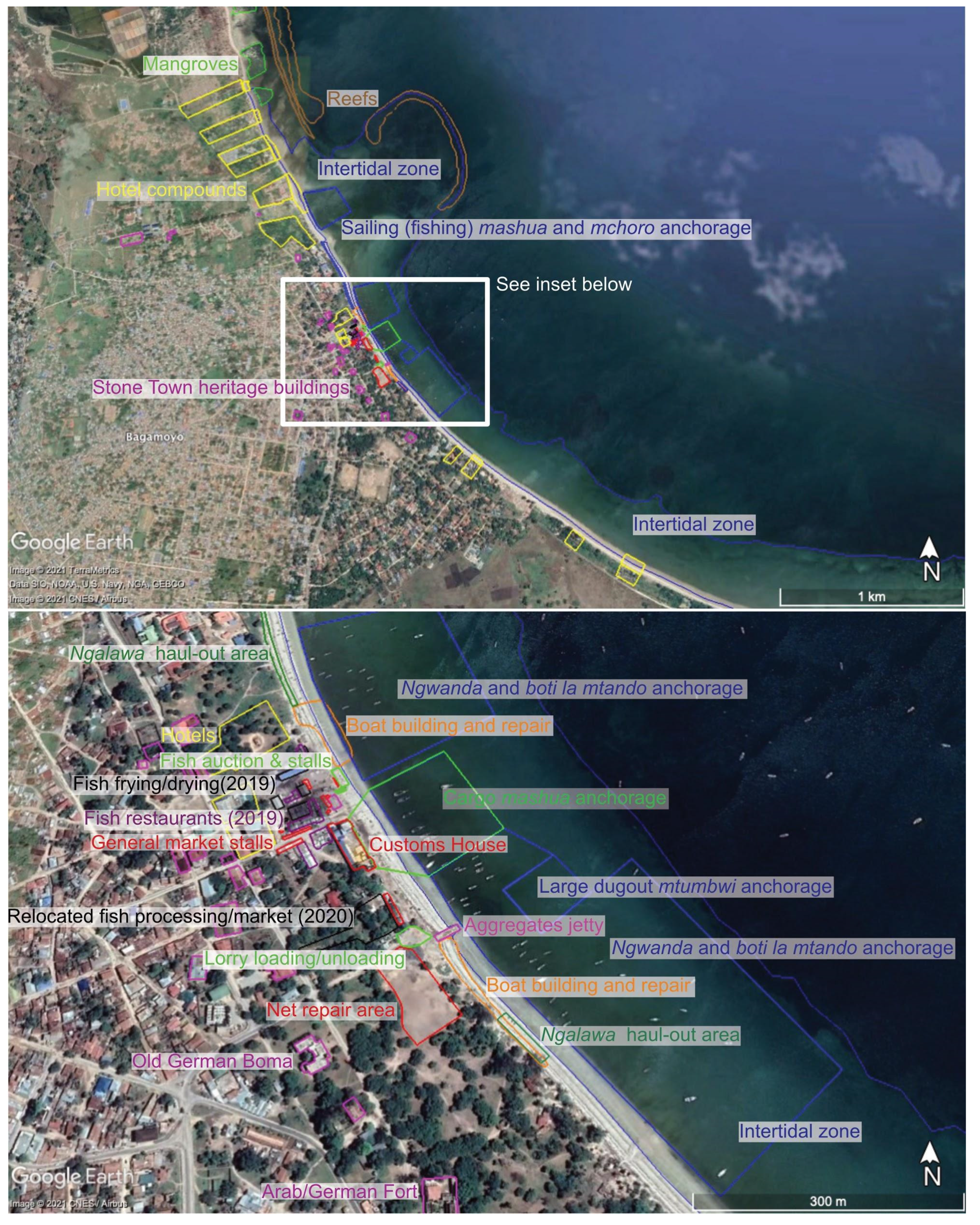
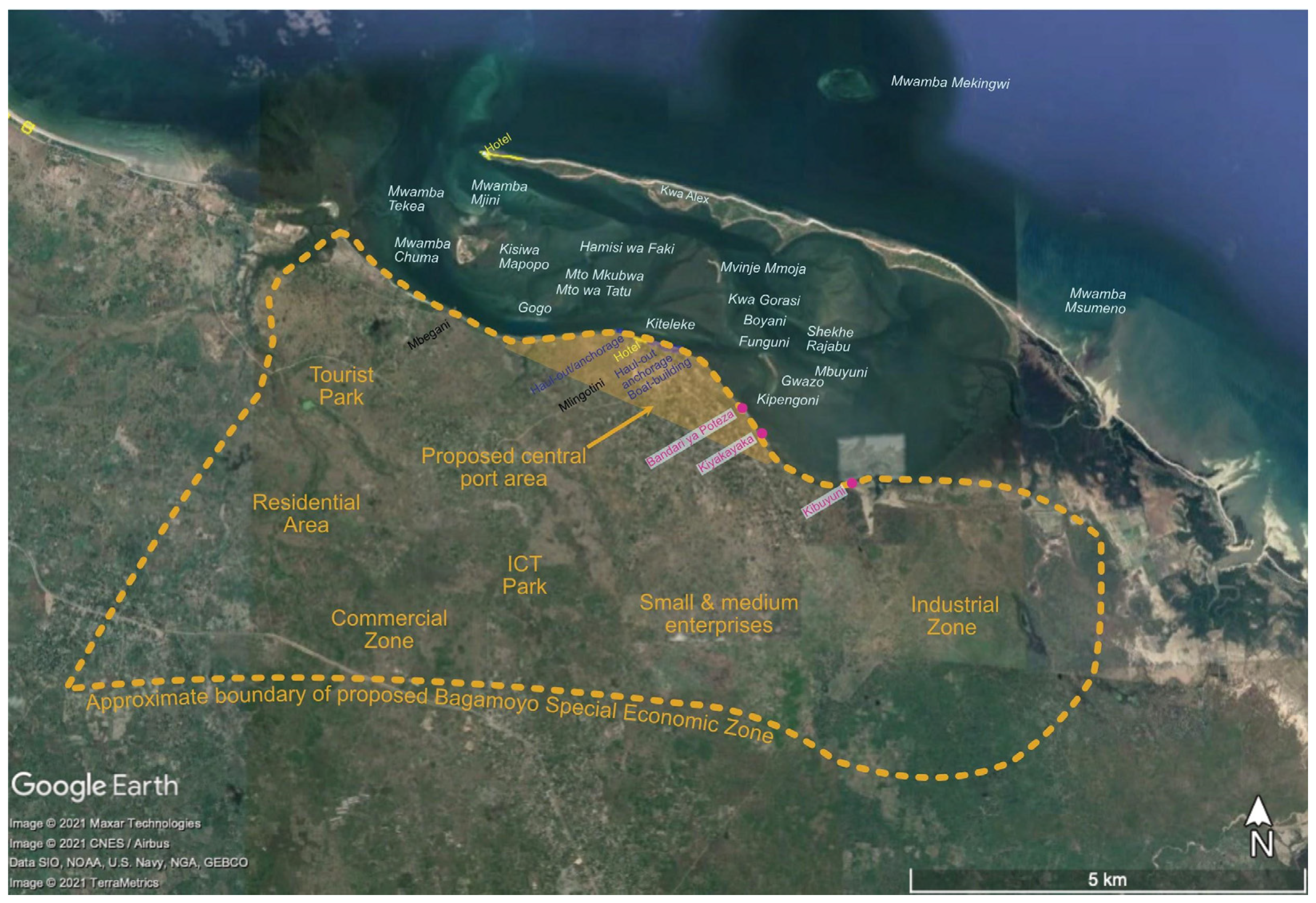
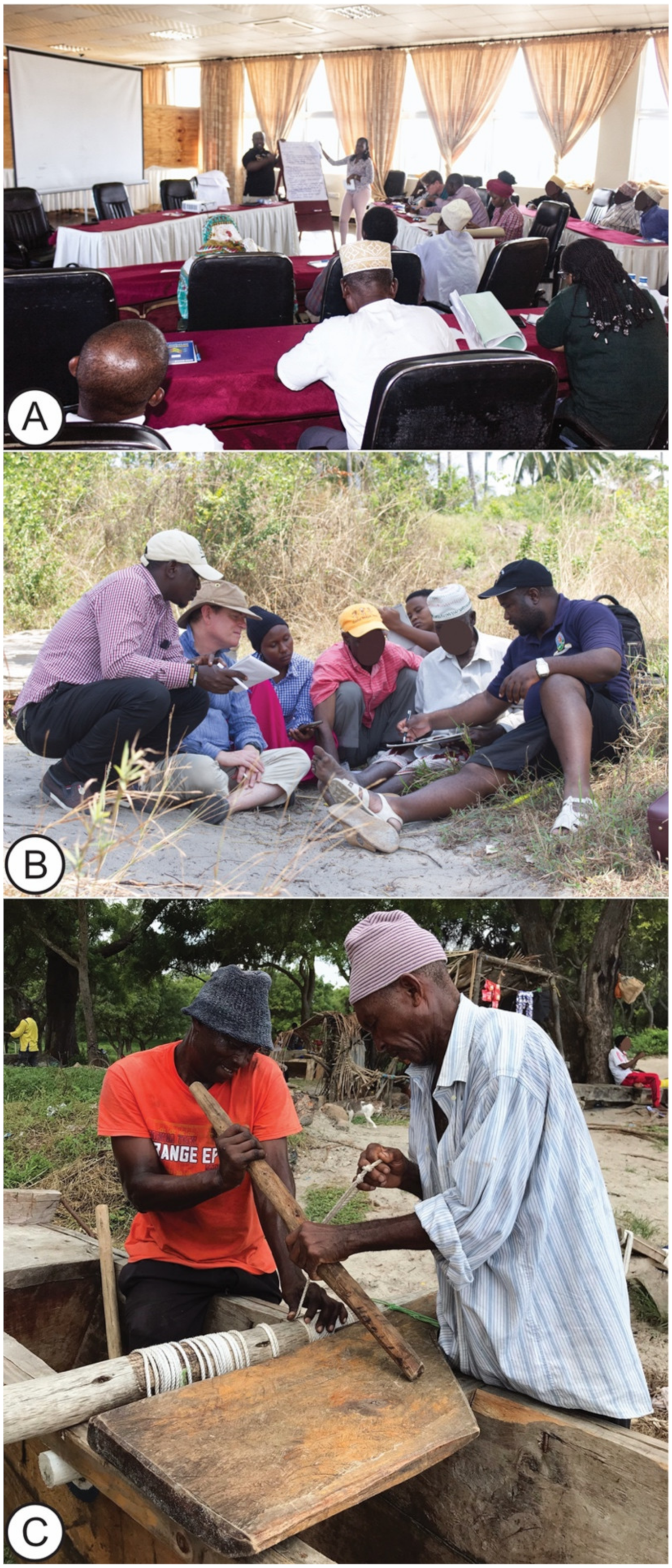
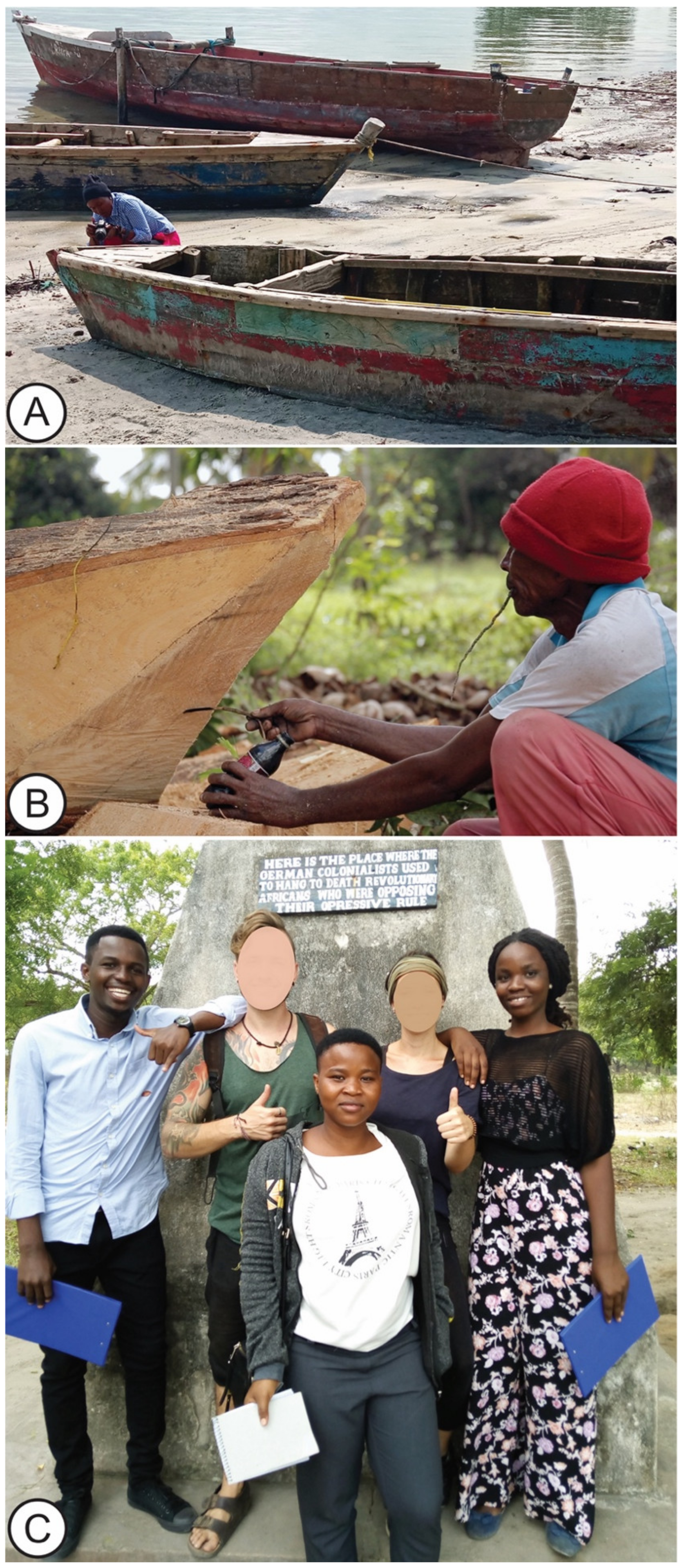
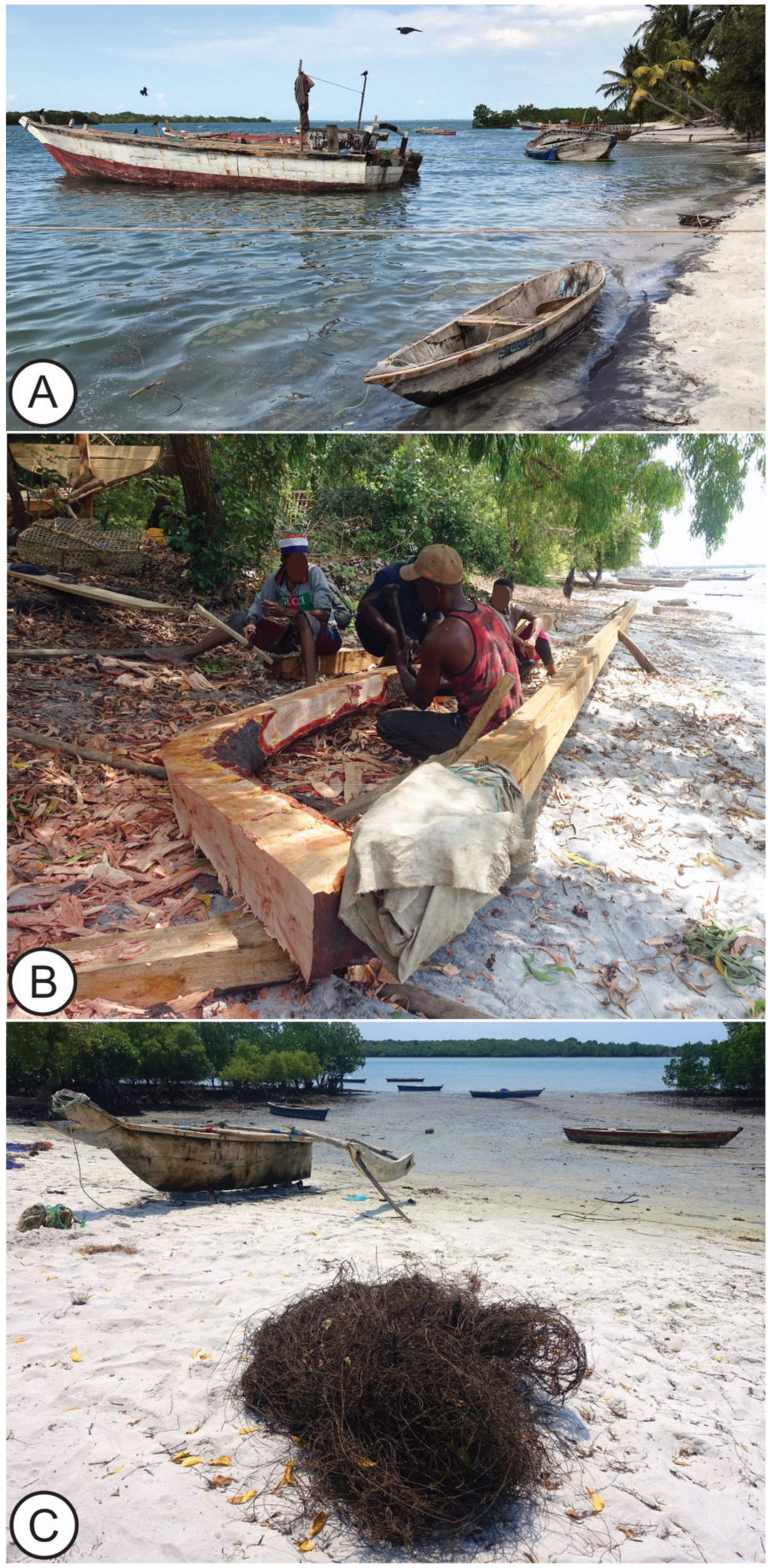
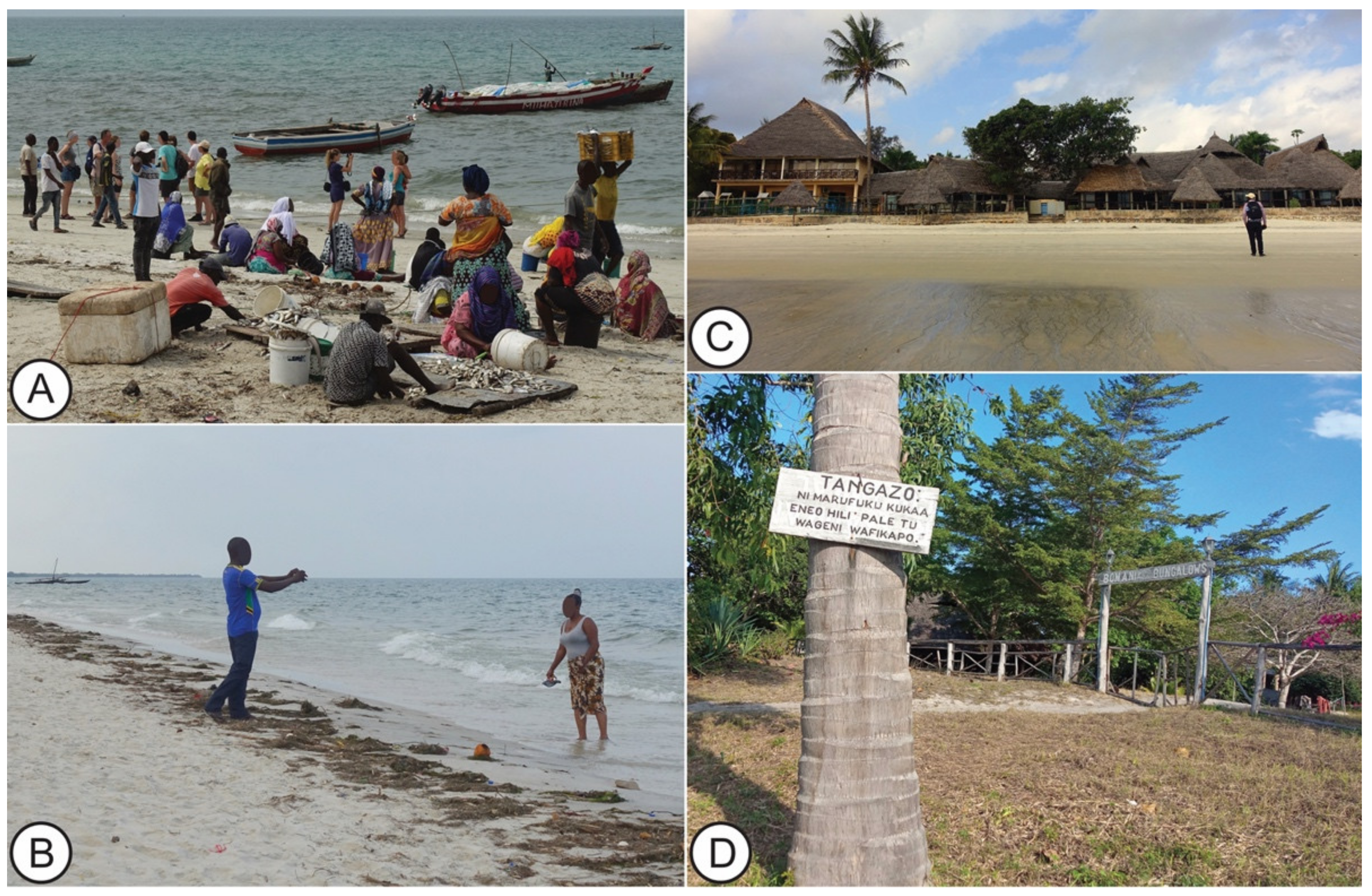

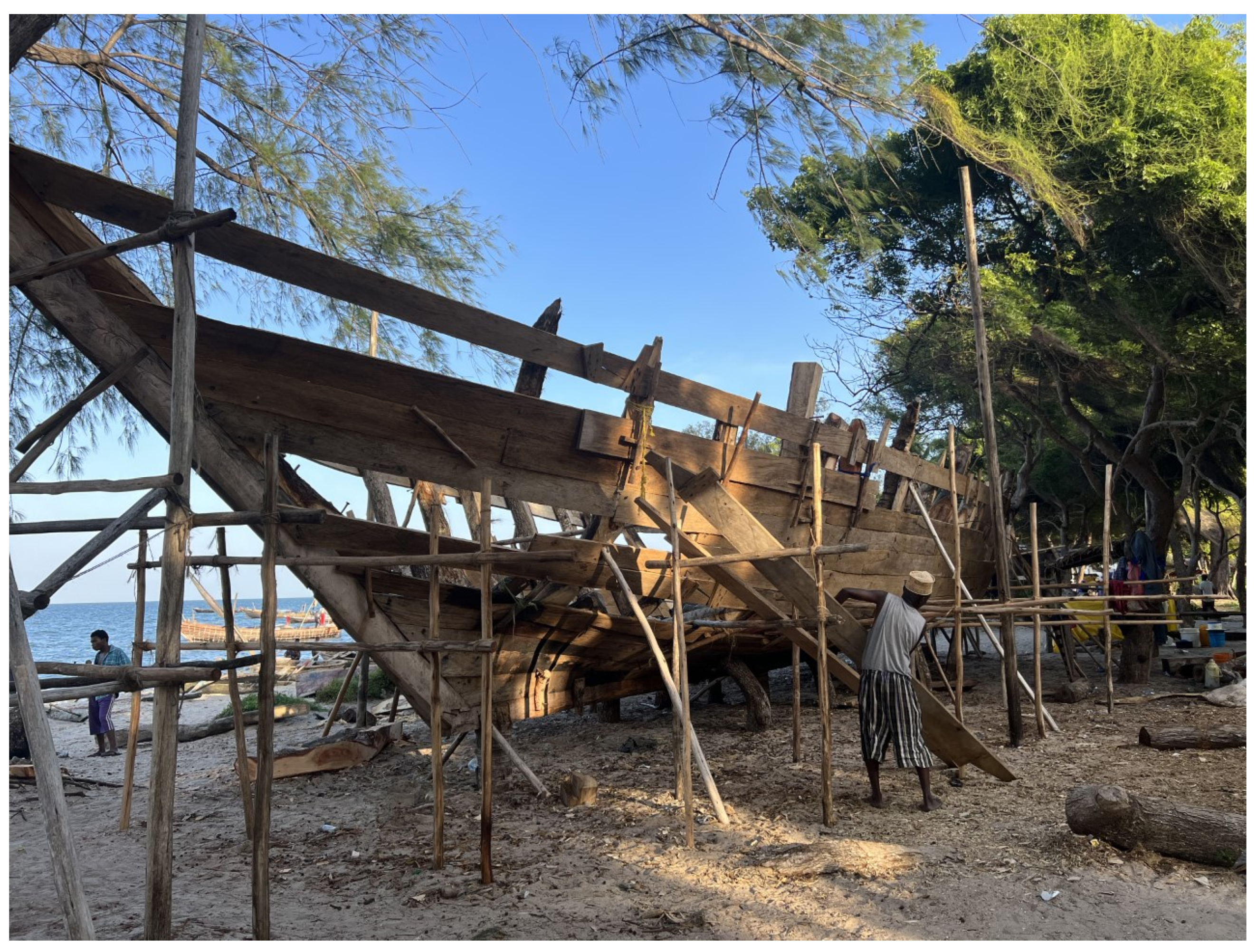
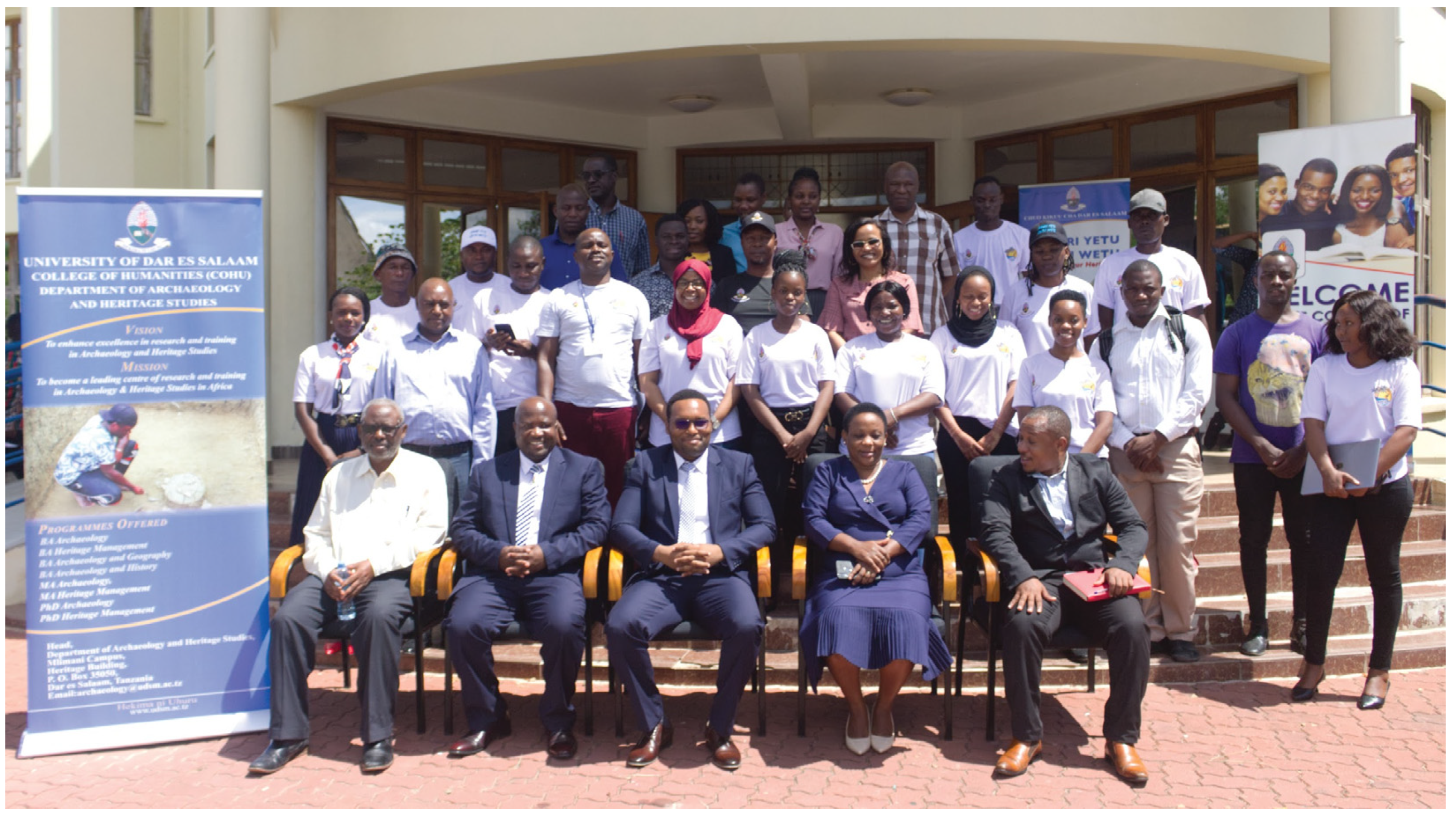
Publisher’s Note: MDPI stays neutral with regard to jurisdictional claims in published maps and institutional affiliations. |
© 2022 by the authors. Licensee MDPI, Basel, Switzerland. This article is an open access article distributed under the terms and conditions of the Creative Commons Attribution (CC BY) license (https://creativecommons.org/licenses/by/4.0/).
Share and Cite
Cooper, J.P.; Ichumbaki, E.B.; Blue, L.K.; Maligisu, P.C.M.; Mark, S.R. When the ‘Asset’ Is Livelihood: Making Heritage with the Maritime Practitioners of Bagamoyo, Tanzania. Heritage 2022, 5, 1160-1198. https://doi.org/10.3390/heritage5020062
Cooper JP, Ichumbaki EB, Blue LK, Maligisu PCM, Mark SR. When the ‘Asset’ Is Livelihood: Making Heritage with the Maritime Practitioners of Bagamoyo, Tanzania. Heritage. 2022; 5(2):1160-1198. https://doi.org/10.3390/heritage5020062
Chicago/Turabian StyleCooper, John P., Elgidius B. Ichumbaki, Lucy K. Blue, Philip C. M. Maligisu, and Sinyati R. Mark. 2022. "When the ‘Asset’ Is Livelihood: Making Heritage with the Maritime Practitioners of Bagamoyo, Tanzania" Heritage 5, no. 2: 1160-1198. https://doi.org/10.3390/heritage5020062
APA StyleCooper, J. P., Ichumbaki, E. B., Blue, L. K., Maligisu, P. C. M., & Mark, S. R. (2022). When the ‘Asset’ Is Livelihood: Making Heritage with the Maritime Practitioners of Bagamoyo, Tanzania. Heritage, 5(2), 1160-1198. https://doi.org/10.3390/heritage5020062







